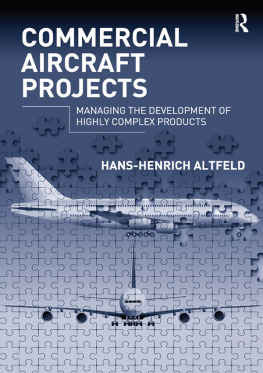
COMMERCIAL AIRCRAFT PROJECTS
Commercial Aircraft Projects
Managing the Development of Highly Complex Products
HANS-HENRICH ALTFELD

First published by 2010 Ashgate Publishing
Published 2016 by Routledge
2 Park Square, Milton Park, Abingdon, Oxon OX14 4RN
711 Third Avenue, New York, NY 10017, USA
Routledge is an imprint of the Taylor & Francis Group, an informa business
Copyright Hans-Henrich Altfeld 2010
Hans-Henrich Altfeld has asserted his moral right under the Copyright, Designs and Patents Act, 1988, to be identified as the author of this work.
All rights reserved. No part of this book may be reprinted or reproduced or utilised in any form or by any electronic, mechanical, or other means, now known or hereafter invented, including photocopying and recording, or in any information storage or retrieval system, without permission in writing from the publishers.
Notice:
Product or corporate names may be trademarks or registered trademarks, and are used only for identification and explanation without intent to infringe.
British Library Cataloguing in Publication Data
Altfeld, Hans-Henrich
Commercial aircraft projects : managing the development of highly complex products.
1. Aeronautics, CommercialManagement. 2. Transport planesDesign and constructionManagement.
I. Title
629.1'33340423-dc22
Library of Congress Cataloging-in-Publication Data
Altfeld, Hans-Henrich.
Commercial aircraft projects : managing the development of highly complex products / by Hans-Henrich Altfeld.
p. cm.
Includes bibliographical references and index.
ISBN 978-0-7546-7753-6 (hardback)
1. Transport planesDesign and construction. 2. Production management. 3. Aircraft industryManagement. 4. Aeronautics, Commercial. I. Title.
TL671.28.A48 2010
629.133068'4dc22
2010009660
ISBN: 9780754677536 (hbk)
Contents
In 1999, Dr. Hans-Henrich Altfeld joined my team to prepare the industrial launch and development of the Airbus A380, the biggest commercial airliner in the world. It was clear from the onset that this development project would represent significant technical, technological, environmental and infrastructure challenges. But the teams participating in the project would also enter new territories in the management of such a huge and complex commercial aircraft project, especially when considering the international and inter-cultural character of Airbus.
However, it quickly became obvious that the application of classical project management techniques to the development of the A380 would not be sufficient to ensure the success of this tremendous project. For one, the sheer complexity of the project would make classical project management very elaborate to an extent which seemed unaffordable for a commercial undertaking. In addition, it had for some time been recognised worldwide that developments in project management were lagging behind the evolution of modern IT- and Concurrent Engineering-based product design and development processes.
With the programme launch imminent, Hans-Henrich proposed new schemes for highly integrated processes for the development phase of the A380. Astonishing results were achieved whenever these new schemes were rigorously implemented and thoroughly applied. This was especially the case in the area of the A380 wing design in the UK, where Hans-Henrich played a leading role.
But Hans-Henrich also recognised that these new schemes would not close the unacceptable and still growing gap between the capabilities of project management on the one hand and product development processes on the other. Many large-scale and complex projects, commercial and military, and including the A380 development project, continued to live with this lack of full compatibility, and, as a result, suffered delays and cost overruns.
Along with many others, Hans-Henrich was not satisfied with the situation. But he took personal initiative by looking into possibilities of how to further reduce the compatibility gap while keeping focused on commercial affordability. After several years of work during his scarce private time, I am very pleased indeed to see that his ideas of how to project manage commercial aircraft developments are now available as a book. As he stresses in many parts of the book, the secret in closing the capability gap lies in integrative management aspects. This comprises integrating different disciplines, which are required to develop complex projects, integrated project architectures and structures, as well as rigor and discipline in adhering to established processes. How exactly this works within the constraints of commercial affordability is the theme of this book.
It is definitely worth noting that many of his findings do not only apply to commercial aircraft developments, although this is the area Hans-Henrich knows best, but also to many other technological fields where complex product developments are taking place. I therefore wish this book a large reading public and a wide circulation within the aerospace community and beyond.
Jrgen Thomas
Toulouse, France
All commercially funded product development projects of very high complexity share a common dilemma. Being complex, it is not sufficient to apply standard project management techniques to manage them and to keep them under control. Instead, they need a much wider management approach which is perfectly adapted to their complex nature. This, however, may generate additional cost. The dilemma arises because in commercially-driven product developments there is the natural tendency to limit the management-related costs associated with such projects.
The development of a new commercial transport aircraft is no exception to this. It certainly is a very challenging and complex undertaking. In fact, in many ways it features additional complexities not found in other projects, even in most other complex projects. The development of a new commercial transport aircraft can therefore be regarded as an extreme example for a commercially-driven, complex product development. This is why I found it especially useful to analyse what is needed in terms of capabilities and practices to manage commercial aircraft developments.
The theme of this book is that any management approach for complex, commercially-driven product developments should seek to integrate the strengths of state-of-the-art management disciplines while limiting their application to some basic essentials. It is therefore integrative and essential at the same time. In other words: whatever the detailed management approach, it should be limited to the minimum amount of capabilities and practices which are necessary to bring together people, processes, methods and tools into a harmonious interoperation to maximise their efficiency and effectiveness.
Wherever in this book a management approach for complex, commercially-driven product developments is discussed, it is intentional to concentrate on the management challenges related to such developments. Other crucial contributors to the success of a complex development project, such as for example the mastering of technical challenges, are therefore not addressed in any depth.
There is an immense amount of literature available on individual management techniques for developing products, such as Project Management, Systems Engineering and Supply Chain Management, to name but a few. However, they tend to deal with the principles of
Next page











